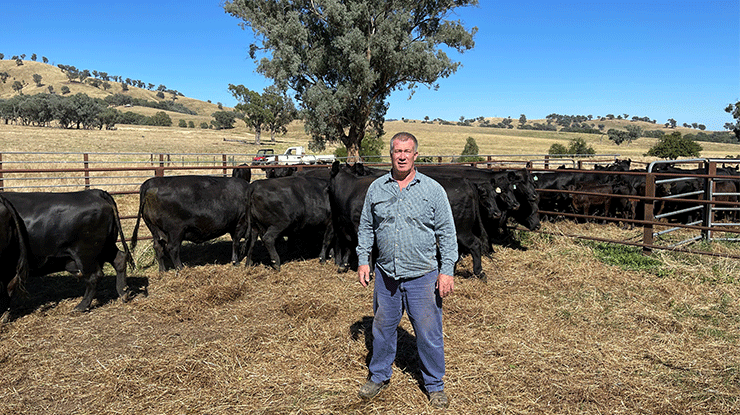
Carbon account shines light on opportunity
When Victorian producer Peter Star undertook carbon accounting for his livestock enterprise for the first time in 2020 he learnt two things: carbon accounting is not as hard as he thought it would be and he's a long way from being carbon neutral.
With his industry involvement as director of Cattle Council Australia, and a Victorian Farmers' Federation Livestock Councillor, he’s very conscious of just how topical carbon accounting will continue to be.
"My main reason for doing the account was just to see what it’s about. Having done it, I thought it was a great exercise. It’s good to be in a position where you can advise people what to look at," he said.
Peter now views his carbon account as a starting point and an important step in seeking community support for producing beef in environmentally friendly farming systems.
"While I might not necessarily become carbon neutral, it’s given me something to strive for and I've identified how to head in that direction," he said.
"From a community point of view, it’s important to have leaders who understand how this works and can lead their community through the early stages."
Peter recommends interested producers undertake carbon accounting to help them understand and identify their challenges.
"It would be a great exercise to undertake as a community group – say with your local Landcare group – where you sit down for a session and work through how you create a carbon account," he said.
Future focus
"A simple way for our farm to be carbon neutral would be to devote 20% of the property to trees. That sounds easy, but the reality is that’s not going to happen," Peter said.
"One way to achieve this would be to fence around all the dams and creeks and plant those areas out to trees and trough the water to the paddocks. Well, that works if the dams and creeks have water in them – but the past three years of less than 50% annual rainfall are proof of the futility of that idea.
"Planting trees is a lot of work and you need good labour sources around to help with it.
"On the other hand, improving perennial pastures is relatively easy. Once you have your seeder set up it is pretty simple."
With these realities in mind, Peter has identified four areas which would support balancing his carbon account in the future:
1. Increasing tree and native vegetation plantation areas
Peter will plant 5ha of trees around a lagoon on his property, which has been empty in recent years. He’s looking at more areas which could be dedicated to trees as he sees the benefits beyond just offsetting emissions, such as improved shade and shelter for livestock and increased biodiversity.
2. Improving pastures
Peter plans to use more phalaris when he renovates pastures, because of its deeper root system compared to some other perennial grasses. While phalaris needs to be well managed, as a deep-rooted perennial it has potential to build soil carbon while providing a long-term feed supply.
3. Turning cattle off sooner
When it comes to turning cattle off faster, Peter looks to genetics and herd management activities to support productivity gains. For instance, when cattle reach their sale weight faster, it shortens their time in the paddock producing methane. This lowers the emissions intensity of a production system.
"Genetics will be part of the answer. What used to take three or four years to do with cattle (grow a 600-700kg animal) can now be done in two years," he said.
He also ensures all cattle perform with early pregnancy scanning and by culling empty breeders.
4. Encouraging dung beetle activity
As dung beetles feed on manure, they incorporate carbon into the soil.
Peter is participating in MLA-supported dung beetle trials and, after earlier releases of dung beetles by Upper Murray Landcare groups, populations are now widespread and highly effective.
|
Get your business CN30‑ready Here are seven ways to be on the front foot towards carbon neutrality. Now 1. Arm yourself with the right knowledge. Identify your emission sources, know what carbon storage options are available and document these in your carbon account. mla.com.au/carbon‑account 2. Consider herd or flock management practices to improve livestock diet, breeding efficiency or structure to reduce methane emissions per kilogram of live weight produced. mla.com.au/erf‑fact‑sheet mla.com.au/reduce‑methane‑emissions 3. Identify shade and shelter options on your property. Integrate trees and shrubs to grazing systems for improved carbon storage and animal health and biodiversity benefits. Your local Landcare group can help you choose the right tree and vegetation species for your region. mla.com.au/tree‑grass‑balance Within three years 4. Plan for delivery and distribution of new feeds and supplements that reduce methane emissions from livestock and improve animal growth rates. This will enable more red meat to be produced for the same or reduced methane emissions. 5. Establish deep‑rooted, palatable pastures and legumes to improve soil carbon levels and lift animal productivity. Longer term 6. Consider what mix of pastures, legumes and trees is suitable to maintain livestock productivity in future weather and climate scenarios. 7. Look at collaborative supply chain arrangements to mitigate financial, environmental and market risks as well as the impact on business inputs and output |
Lessons learned
- Carbon accounting is valuable to know if you’re on the right track, especially if you decide to pursue carbon neutrality.
- Build your understanding of how the livestock sector is working towards carbon neutrality through industry engagement.
- Plan ahead to ensure future plantations meet carbon accounting guidelines.



